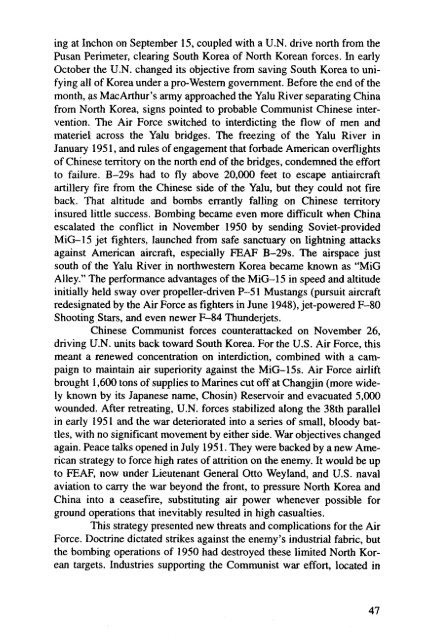A Concise History of the US Air Force - Air Force Historical Studies ...
A Concise History of the US Air Force - Air Force Historical Studies ...
A Concise History of the US Air Force - Air Force Historical Studies ...
Create successful ePaper yourself
Turn your PDF publications into a flip-book with our unique Google optimized e-Paper software.
ing at Inchon on September 15, coupled with a U.N. drive north from <strong>the</strong><br />
Pusan Perimeter, clearing South Korea <strong>of</strong> North Korean forces. In early<br />
October <strong>the</strong> U.N. changed its objective from saving South Korea to uni-<br />
fying all <strong>of</strong> Korea under a pro-Westem government. Before <strong>the</strong> end <strong>of</strong> <strong>the</strong><br />
month, as MacArthur’s army approached <strong>the</strong> Yalu River separating China<br />
from North Korea, signs pointed to probable Communist Chinese inter-<br />
vention. The <strong>Air</strong> <strong>Force</strong> switched to interdicting <strong>the</strong> flow <strong>of</strong> men and<br />
materiel across <strong>the</strong> Yalu bridges. The freezing <strong>of</strong> <strong>the</strong> Yalu River in<br />
January 195 1, and rules <strong>of</strong> engagement that forbade American overflights<br />
<strong>of</strong> Chinese territory on <strong>the</strong> north end <strong>of</strong> <strong>the</strong> bridges, condemned <strong>the</strong> effort<br />
to failure. B-29s had to fly above 20,000 feet to escape antiaircraft<br />
artillery fire from <strong>the</strong> Chinese side <strong>of</strong> <strong>the</strong> Yalu, but <strong>the</strong>y could not fire<br />
back. That altitude and bombs errantly falling on Chinese temtory<br />
insured little success. Bombing became even more difficult when China<br />
escalated <strong>the</strong> conflict in November 1950 by sending Soviet-provided<br />
MiG-15 jet fighters, launched from safe sanctuary on lightning attacks<br />
against American aircraft, especially FEAF B-29s. The airspace just<br />
south <strong>of</strong> <strong>the</strong> Yalu River in northwestern Korea became known as “MiG<br />
Alley.” The performance advantages <strong>of</strong> <strong>the</strong> MiG-15 in speed and altitude<br />
initially held sway over propeller-driven P-5 1 Mustangs (pursuit aircraft<br />
redesignated by <strong>the</strong> <strong>Air</strong> <strong>Force</strong> as fighters in June 1948), jet-powered F-80<br />
Shooting Stars, and even newer F-84 Thunderjets.<br />
Chinese Communist forces counterattacked on November 26,<br />
driving U.N. units back toward South Korea. For <strong>the</strong> U.S. <strong>Air</strong> <strong>Force</strong>, this<br />
meant a genewed concentration on interdiction, combined with a cam-<br />
paign to maintain air superiority against <strong>the</strong> MiG-15s. <strong>Air</strong> <strong>Force</strong> airlift<br />
brought 1,600 tons <strong>of</strong> supplies to Marines cut <strong>of</strong>f at Changjin (more wide-<br />
ly known by its Japanese name, Chosin) Reservoir and evacuated 5,000<br />
wounded. After retreating, U.N. forces stabilized along <strong>the</strong> 38th parallel<br />
in early 1951 and <strong>the</strong> war deteriorated into a series <strong>of</strong> small, bloody bat-<br />
tles, with no significant movement by ei<strong>the</strong>r side. War objectives changed<br />
again. Peace talks opened in July 1951. They were backed by a new Ame-<br />
rican strategy to force high rates <strong>of</strong> attrition on <strong>the</strong> enemy. It would be up<br />
to FEAF, now under Lieutenant General Otto Weyland, and U.S. naval<br />
aviation to carry <strong>the</strong> war beyond <strong>the</strong> front, to pressure North Korea and<br />
China into a ceasefire, substituting air power whenever possible for<br />
ground operations that inevitably resulted in high casualties.<br />
This strategy presented new threats and complications for <strong>the</strong> <strong>Air</strong><br />
<strong>Force</strong>. Doctrine dictated strikes against <strong>the</strong> enemy’s industrial fabric, but<br />
<strong>the</strong> bombing operations <strong>of</strong> 1950 had destroyed <strong>the</strong>se limited North Kor-<br />
ean targets. Industries supporting <strong>the</strong> Communist war effort, located in<br />
47
















